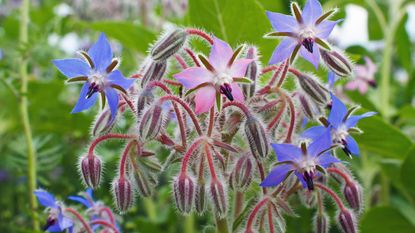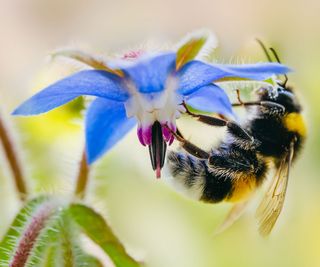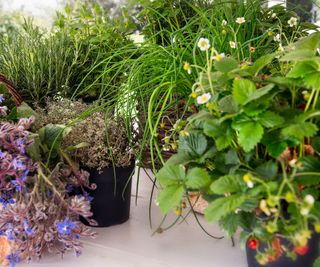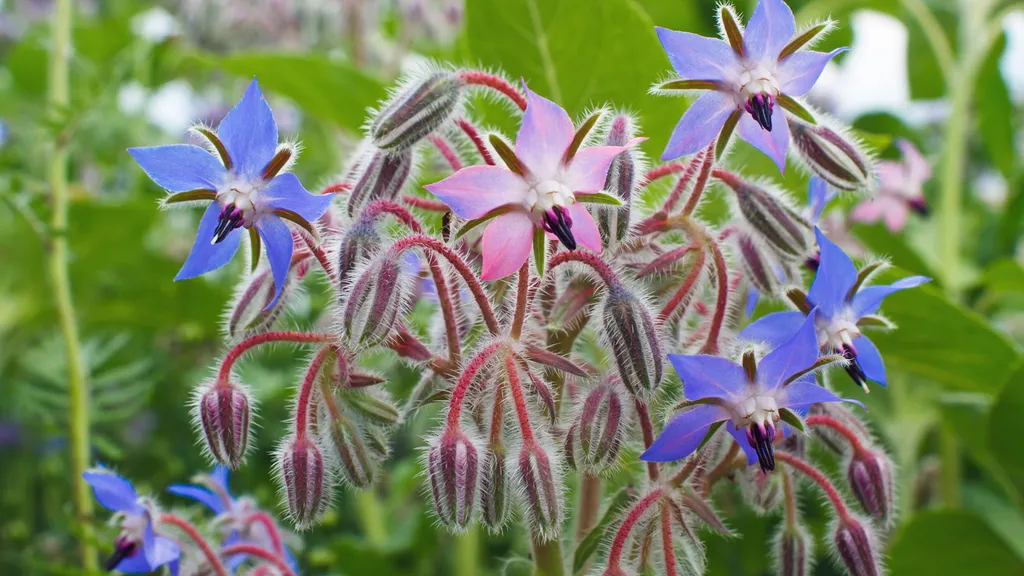
Planting borage is your ticket to enjoying one of the most underrated and versatile annual herbs in the edible garden. The borage plant (Borago officinalis) is an old-fashioned ornamental herb that produces beautiful flowers beloved by pollinators. Both the foliage and the borage flower are edible. Its brilliant blue, star-shaped blooms lends a fresh cucumber-like flavor to iced teas and other drinks. Meanwhile, its leaves are best eaten when tender or cooked like spinach.
The borage plant is native to Syria and the Eastern Mediterranean, but grows wild in the UK in certain regions. Its scientific name means ‘father of roughness’ – referring to the rough texture of its hairy leaves. It is cultivated primarily as a garden herb in Europe and North America. However, thanks to its pollinator-friendly allure, it is ideal for growing in a butterfly garden and is a lovely way to bring pollinators to your veggies.

Growing Borage from Seed
Start borage seeds in early spring, as soon as your soil is workable and has warmed. Warmer soil will result in earlier germination. Prepare the soil by removing roots, rocks and other impediments to germination. Make sure it is and has a medium pH range.
When growing borage from seed, sow directly into the soil after the last date of frost. Cover seeds with soil that’s twice their thickness, spaced 15in (38cm) apart. Keep the soil lightly moist, and you can expect germination in seven-14 days.
Best Borage Plant Care
The borage plant is an annual that does not stand up well to cold temperatures. Borage plants die back when a killing frost occurs. They are somewhat rangy, with stems and leaves that are covered in bristly hair. However, the following cultivation essentials will ensure that you can make your borage plants last for as long as possible, and as healthy as possible:
- Lighting Conditions: Borage grows rapidly from seed sown in spring as soon as soil is workable. It is adaptive to both full and partial sun situations. Full shade areas will reduce the formation of the flowers and cause leggy plants. Borage makes an excellent addition to the herb or wildflower garden, where bees and other pollinators will visit the flowers consistently.
- Best Watering: Borage plants do not tolerate drought conditions, especially when young. Established plants can survive brief periods without water, but leaf and flower production can suffer. Consistent moisture gives best growth. As seedlings begin to form, water the young plants every few days. When the plant is mature with a full root system, allow the soil to dry out between waterings, then water deeply.
- Soil & Compost: Borage is almost weedlike in its acceptance of any type of soil. Rich, organic soil will provide the quickest, best growth, but borage is tolerant of poor soils, and even heavy clay. Sand and loam are good media. Planting borage in slightly acidic, well-draining, moderately fertile soil will result in quicker, healthier plants. Nutrient-poor soils result in even bluer flowers.
- Temperature & Humidity: Borage seeds germinate quickly when sown in soil that is 60 degrees Fahrenheit (15.56°C). Once the plant is mature, it can withstand temperatures to 50°F (10°C.) for short periods. It is hardy to USDA zones 3-10. In areas with high humidity, only water when the soil is dry to prevent fungal issues. Otherwise, it is tolerant of arid to humid ambient conditions.
- Fertilizing: One cultivation shortcut when learning how to grow borage is that it needs little feeding. The plant will perform perfectly well in poor soil. However, flowers and tender new leaves will be more prolific in soil amended with a bit of compost or other organic matter.

Problems, Pests & Diseases
Borage is unbothered by most insects and has no significant disease threats. The black fly aphid may pose an occasional problem. You can treat this with a horticultural soap. You might also notice powdery mildew if the plant is watered overhead and has no chance to dry before nightfall in warm months. Otherwise, however, this aspect of borage plant care is simple and relatively free from bother.
Pruning Borage Plants
Borage doesn’t need pruning, but can be cut by a third with no ill effects. You can cut off young leaves for use in cooking and flowers when they are new and fresh. For a continuous supply of young leaf matter, you should remember to sow more borage seeds every three weeks during the growing season.
How to Harvest Borage
For good borage plant care, make sure you the right way. Harvest young leaves by cutting the stem away from the plant. Never harvest more than a third of the plant material at one time. For the best flavor, harvest the flowers in the morning when they are still dew covered. If the plant is grown for seed, allow the flowers to mature on the plant before harvesting the blooms.
Borage Propagation
Borage can be perpetuated by allowing the flowers to go to seed and self-sow. It grows quickly as an annual, and won’t take long to colonize a corner of the garden, reappearing year after year.

